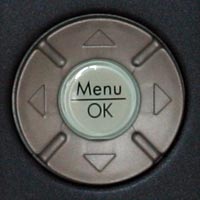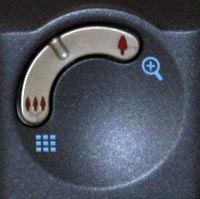HP Photosmart M407
Review Date: December 2nd 2004
|
Ease of Use
The HP Photosmart M407 is one of those digital cameras that looks better in a product photograph than in real life, in that the split light grey/dark grey colourscheme looks classy and understated in a photo, but not particularly exciting in reality. Unsurprisingly at this price-point the camera is entirely made of plastic, which is also part of the reason for that initial sense of disappointment, as it doesn't feel as expensive as it looks. The HP Photosmart M407 just about squeezes into the pocketable category of digital cameras, but it's certainly not that compact given that it only has a 3x optical zoom lens. All of that plastic does make it quite a light camera, however, (146g) which may be a good thing if you want a camera that is easy to carry around or a bad thing if you want one that feels a little more durable.
The HP Photosmart M407 is very comfortable to hold thanks to an innovative zoom button design. The HP designers have placed a large curved recess just where your right-hand thumb naturally sits, with the zoom button arching round in a 90 degree curve at the top of the recess. This design makes the camera easy to grip and also very easy to operate the zoom. I've not seen anything like before so kudos to HP for trying something a little different (and making it work).
| Controller | Zoom Lever |
 |
 |
Other nice external features that tie in with the whole HP ethos of ease of use are the separate shutter buttons on the top of the camera, one for still images and one for movies. At first I was a little confused as I struggled to find anything to do with movies in the menu system or scene modes - then I realised that pressing the smaller movie shutter button simply starts recording a movie, with pressing it again stopping the recording. This makes switching between still and moving images very quick and intuitive. HP have carried on this approach of removing menu items and making them accessible via external buttons with a vertical row of 4 buttons on the left hand side of the camera's rear. Activating the various flash settings, scene modes and timer options is as easy as pressing the appropriate button to cycle through the available choices.
Yet despite making so many controls available externally, HP have still done a good job in designing a camera that doesn't have too many buttons and switches to confuse the new photographer that it is aimed at. There are 12 external controls in total, with all of them are clearly labeled using industry-standard symbols and terminology. If you have never used a digital camera before, or you're upgrading from a more basic model, reading the comprehensive and easy-to-follow manual before you start is a good idea. For more experienced users, a quick look through the manual for the few functions that are not so self-explanatory (like HP's unique InstantShare feature) is all that's needed.
As well as the useful manual, HP have added something to the Photosmart M407 that I have never seen before on any other digital camera (apart from other HP models) - a context sensitive help option built into the menu system. It perhaps doesn't sound like much, but if you're using a menu option for the first time and you're not quite sure what it means, having the option of reading an explanation in clear English (or whatever language you choose) on the camera's LCD screen is a great idea. You may not use the help system when you are more familiar with the camera, but in those first few weeks it could mean the difference between successfully taking a photo or not.
| Flash / Mode / Timer / Instant Share Buttons | On/Off Switch |
 |
|
HP have also gone a step further with the Photosmart M407 by adding a whole menu dedicated to providing extra essential information, called somewhat unsurprisingly the Help menu. There are 14 options dealing with a variety of topics, from Top Ten Tips to Using Shooting Modes and Printing Images. It's essentially like having a miniature version of the user manual in your camera, and although not quite as useful as the context sensitive help, still a welcome addition that can only make the M407 even easier to understand and use.
The menu system of the HP Photosmart M407 is as well designed as the exterior of the camera. It uses an intuitive tabbed interface with 5 options at the top of the screen, Capture, Playback, Instant Share, Setup and Help, which are represented by easily understandable icons. There are only ever a maximum of about 8 options per tab so there isn't too much scrolling through an endless list trying to find that elusive option. The Capture Menu in particular only has a few options due to HP placing so many functions on the exterior of the camera. The generous 1.8 inch LCD screen of the HP Photosmart M407 makes a big difference to using the menu system, as all the options are clearly displayed in a generously sized typeface. There is also a useful symbol next to each menu option to help indicate what it does, and this combined with the help system ensures that the HP Photosmart M407 menus are extremely easy to access and use.
So the HP Photosmart M407 is comfortable to hold, easy to operate and has a very simple to use menu system, but what is it like to actually operate and take a photo? The start-up time from turning the camera on to being ready to take a photo is respectable enough at around 1.5 seconds, whilst it takes less than 1 second to zoom from the widest focal length to the longest. At this point I would like to with you share what for me is one of the worst aspects of the HP Photosmart M407 - the extremely noisy zoom lens, which I'm sure could scare animals and small children (and possibly adults too). All joking aside, it really is one of the loudest zooming mechanisms that I have ever heard, emitting a sound not unlike a dentist's drill. The M407 is not the best choice if you don't want anyone within a 3m distance to notice that you are there.
| Camera Dock Connector | Shutter Button / Video Button |
 |
 |
Focusing is generally quick in good light, although the camera does really struggle to focus indoors or in low-light situations if the flash is not turned on. The visibility of the LCD screen is perfectly acceptable, although the refresh rate occasionally lags behind if you quickly move the camera, for example when tracking a quick-moving subject. Images are stored without any noticeable delay, allowing you to keep shooting as they are being recorded onto the memory card. In continuous mode (called Burst mode) the camera takes 3 photos in less than 1 second, but subsequent shots in the same sequence are taken and recorded much more slowly. All in all the HP Photosmart M407 is about average in terms of operational speed.
Once you have captured a photo, the HP Photosmart M407 is slightly disappointing when it comes to playing, reviewing and managing your images. You can scroll through the images that you have taken, view thumbnails, zoom in and out, add an audio clip to each image, delete an image and rotate an image. Through HP's Instant Share feature, you can print 1 or 2 copies of an image and designate images to be automatically emailed when you download them. The HP Photosmart M407 does not have a histogram function, either before taking a photo or after, so evaluating the exposure of a photo can only be done by you looking at it onscreen. This is a feature that is now found on many low-end digicams, so the Photosmart M407 loses out in this respect. Also missing are nice-to-have features like locking images so that they can't be deleted and more options for manipulating images in-camera.
On the whole the HP Photosmart M407 is an extremely easy to use digital camera, with a well-designed exterior and a great menu system. On the downside, it has one of the noisiest zoom lenses that I have ever heard, average performance and average playback features.
|
 PhotographyBLOG is a member of the DIWA organisation. Our test results for the HP Photosmart M407 have been submitted to DIWA for comparison with test results for different samples of the same camera model supplied by other DIWA member sites.
PhotographyBLOG is a member of the DIWA organisation. Our test results for the HP Photosmart M407 have been submitted to DIWA for comparison with test results for different samples of the same camera model supplied by other DIWA member sites.
